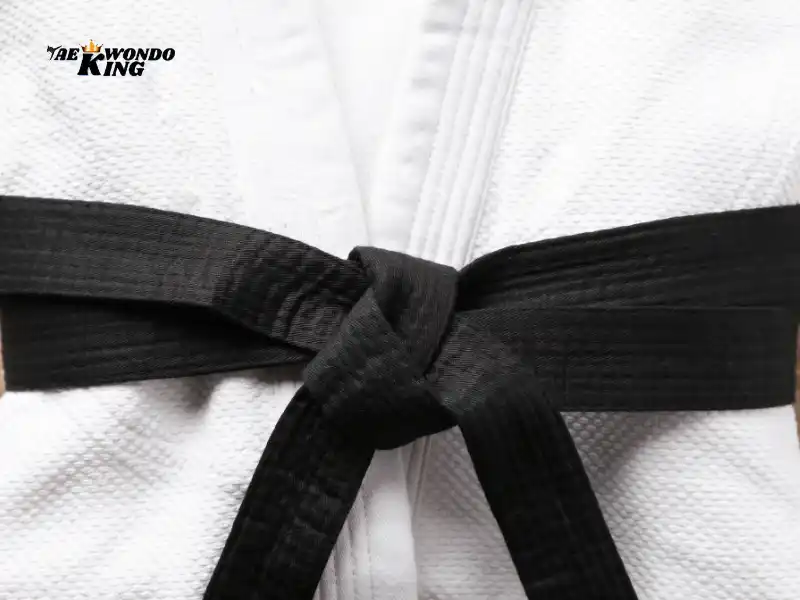
Taekwondo, a martial art known for its powerful kicks, dynamic movements, and strict code of conduct, employs a belt system to signify a practitioner’s level of expertise. Among the various belts, the “Poom” belt holds a unique position, often sparking curiosity among Taekwondo enthusiasts. In this comprehensive guide, we will delve into the essence of the Poom belt, exploring its significance, requirements, and its role in the journey of a Taekwondo practitioner.
The Poom belt, also known as the black belt, holds significant meaning in Taekwondo. It symbolizes mastery and achievement in the martial art, representing years of training, dedication, and discipline. In this article, we will delve into the history and meaning of the Poom belt in Taekwondo, as well as the requirements and responsibilities that come with earning it. Whether you are an experienced practitioner or simply curious about martial arts, understanding the significance of the Poom belt is important.
What is Poom in Korean?

In Taekwondo, a Poom belt is associated with practitioners who have achieved a certain level of proficiency but have not yet reached the age or maturity required for a full Dan (black belt) certification. The term “Poom” is often used in the context of junior black belts. Here are key points about the Poom belt:
- Poom Certification: Alongside the Poom belt, practitioners are awarded a Poom certificate. This certification acknowledges their achievements and progress in Taekwondo but indicates that they are in a transitional stage between the colored belt ranks and the full black belt (Dan) ranks.
- Age Requirement: The Poom belt is typically awarded to younger practitioners, such as children or teenagers, who have demonstrated the necessary skills and knowledge to advance beyond the colored belt levels but have not yet reached the age required for a full black belt.
- Poom Belt Appearance: The Poom belt often looks similar to a black belt but may have a colored stripe running along its length, differentiating it from the solid black belts of higher dan ranks. The specific color of the stripe can vary but is commonly red or another color that contrasts with the black.
- Testing Criteria: To attain a Poom belt, practitioners must meet specific testing criteria, which may include demonstrating forms (patterns), sparring skills, breaking techniques, and a theoretical understanding of Taekwondo principles. The testing requirements are usually tailored to the age and physical abilities of the practitioner.
- Advancement to Dan Ranks: As practitioners with Poom belts age and accumulate more experience, they may have the opportunity to convert their Poom certification to a full Dan certification by undergoing additional testing. This transition often occurs when the practitioner becomes eligible for the adult black belt ranks.
Understanding the Belt Hierarchy in Taekwondo:

Before diving into the specifics of the Poom belt, it’s crucial to grasp the overall structure of the belt hierarchy in Taekwondo. The colored belt system, which represents different stages of learning and mastery, serves as a roadmap for practitioners on their martial arts journey.
It’s important to note that the specific policies regarding Poom belts may vary among Taekwondo schools and organizations. Poom belt system provides a structured way for young practitioners to progress through the martial arts ranks, acknowledging their achievements while preparing them for the responsibilities associated with higher black belt ranks.
The Poom Belt: A Distinctive Aspect of Taekwondo:

The term “Poom” is often associated with junior black belts in Taekwondo. Unlike the solid black belt, Poom belts typically feature a colored stripe running along their length, symbolizing a stage of transition from colored belts to the coveted black belt.
Poom Belt vs. Black Belt: Clarifying the Distinctions:

One of the common misconceptions is the confusion between Poom belts and traditional black belts. This section will highlight the key differences between the two, emphasizing the significance of the Poom belt as a stepping stone towards the coveted black belt.
What is Poom Belt vs Black Belt
In Taekwondo, the Poom belt and the black belt represent different stages of progression within the martial art. Here are the key distinctions between the two:
Poom Belt:
- The Poom belt is associated with junior black belts in Taekwondo.
- It is a transitional stage for practitioners who have achieved a certain level of proficiency but have not yet reached the age or maturity required for a full Dan (black belt) certification.
- Practitioners with a Poom belt are typically younger individuals, such as children or teenagers, who have demonstrated advanced skills and knowledge in Taekwondo.
- The Poom belt often looks similar to a black belt but may have a colored stripe running along its length, distinguishing it from the solid black belts of higher dan ranks.
Black Belt:
- The black belt is a symbol of advanced proficiency and expertise in Taekwondo.
- It represents the highest rank achievable in the martial art, and practitioners holding a black belt are considered to have attained a significant level of skill, knowledge, and dedication.
- Black belts are further categorized into different degrees or dans, with higher dans indicating a deeper understanding of Taekwondo techniques, philosophy, and principles.
- Achieving a black belt is a significant milestone, but it does not mark the end of a practitioner’s journey; rather, it signifies a new beginning and a commitment to continuous learning and improvement.
In summary, the Poom belt is a stage between colored belts and the black belt, often associated with younger practitioners, while the black belt represents the pinnacle of achievement in Taekwondo and encompasses various degrees reflecting different levels of expertise.
What is Poom Belt vs Black Belt which is Better?
The comparison between a Poom belt and a black belt in Taekwondo isn’t about which one is “better” but rather about understanding their respective roles and significance in a practitioner’s martial arts journey.
Poom Belt:
- The Poom belt is a junior black belt, typically awarded to younger practitioners who have demonstrated advanced skills and knowledge in Taekwondo but have not yet reached the age or maturity required for a full Dan (black belt) certification.
- It serves as a transitional stage, acknowledging the practitioner’s progress beyond colored belts and preparing them for higher-level training.
- The Poom belt allows young individuals to continue their development and prepare for the responsibilities associated with higher dan ranks as they mature.
Black Belt:
- The black belt is the highest rank in Taekwondo and signifies advanced proficiency, expertise, and dedication to the martial art.
- Achieving a black belt is a significant milestone, but it is not the end of a practitioner’s journey; rather, it marks the beginning of a new phase of learning and leadership within the Taekwondo community.
- Black belts are further categorized into different degrees or dans, with higher dans representing deeper understanding and mastery.
Neither the Poom belt nor the black belt is inherently “better” than the other; they serve different purposes in the overall progression of a martial artist. The choice between the two depends on factors such as age, experience, and the individual’s stage of development within the martial art. Both belts contribute to a well-rounded and continuous martial arts journey.
Poom Belt Requirements and Testing:

Attaining a Poom belt involves a rigorous testing process, combining elements of both physical and mental prowess. This section will outline the specific requirements and criteria that practitioners must meet to progress from colored belts to the Poom belt level.
The Role of Poom Belt in Skill Development:
Beyond its symbolic value, the Poom belt plays a crucial role in the continuous development of a Taekwondo practitioner’s skills. This section will discuss how the Poom belt stage focuses on refining techniques, deepening understanding, and preparing individuals for the responsibilities that come with a black belt.
Poom Belt and the Young Practitioner:
Taekwondo is often embraced by individuals of all ages, including children and teenagers. This section will explore how the Poom belt caters to the younger demographic, providing a balanced approach to skill development and discipline.
The Significance of Poom Belt in Traditional and Modern Taekwondo:
As martial arts evolve, the role of the Poom belt may vary across different schools and styles of Taekwondo. This section will examine the historical context of the Poom belt and its adaptation in contemporary Taekwondo practices.
What is the difference between Dan and Poom?

In the world of Taekwondo, the path to mastery is marked by a progression through various belt levels, each carrying its own significance. Two terms that often pique the curiosity of practitioners are “Dan” and “Poom.” In this comprehensive exploration, we aim to shed light on the key distinctions between Dan and Poom, unraveling the mystery behind these pivotal stages in a martial artist’s journey.
Understanding the Belt System in Taekwondo:
Before delving into the nuances of Dan and Poom, it’s crucial to grasp the fundamentals of the belt system in Taekwondo. This section will provide an overview of how practitioners ascend through colored belts before reaching the coveted black belt level.
Dan: The Prestigious Black Belt Realm:
The term “Dan” is synonymous with the black belt, signifying a high level of expertise and proficiency in Taekwondo. This section will delve into the significance of the Dan belt, exploring its various degrees and the responsibilities that come with attaining this prestigious rank.
Poom: The Bridge Between Colored Belts and Dan:

In contrast to the solid black belt, the Poom belt serves as a transitional stage, often referred to as the junior black belt. This section will elucidate the unique characteristics of the Poom belt, including its appearance, testing requirements, and its role as a stepping stone toward the Dan ranks.
Testing Criteria for Dan and Poom:
Advancing to a new belt level in Taekwondo involves rigorous testing, and the criteria for Dan and Poom are no exception. This section will outline the specific requirements for practitioners aiming to progress from colored belts to Poom and eventually to the esteemed Dan ranks.
Differences in Skill Emphasis: Poom’s Developmental Focus:
While both Dan and Poom signify advanced stages in a martial artist’s journey, they differ in their emphasis on skill development. This section will explore how Poom places a particular focus on refining techniques, deepening understanding, and preparing practitioners for the responsibilities associated with a black belt.
Age Considerations: Poom as a Gateway for Young Practitioners:
Taekwondo attracts individuals of all ages, including children and teenagers. This section will discuss how the Poom belt is tailored to cater to the developmental needs of younger practitioners, serving as a bridge between the colorful world of colored belts and the sophistication of the black belt.
The Evolution of Dan and Poom in Modern Taekwondo:
As martial arts practices evolve, the roles and perceptions of Dan and Poom may vary across different schools and styles. This section will explore how these designations have adapted to the changing landscape of contemporary Taekwondo.
In the intricate tapestry of Taekwondo, the distinctions between Dan and Poom represent pivotal milestones in a practitioner’s journey toward martial arts mastery. Understanding the unique characteristics, testing criteria, and developmental emphasis of each belt level enhances one’s appreciation for the depth and tradition embedded in this ancient and revered martial art.
Is there a higher belt than Black in Taekwondo?

In traditional Taekwondo, the black belt is generally considered the highest rank. However, within the black belt category, there are different degrees or dans. The dan system is used to signify the level of expertise or proficiency of a black belt practitioner. For example, a first-degree black belt is denoted as 1st Dan, a second-degree black belt as 2nd Dan, and so on.
The dan system can extend to very high levels, with some practitioners achieving 9th or even 10th Dan. Each higher dan degree typically reflects a deeper understanding of the art, increased skill level, and a significant contribution to the martial arts community.
It’s important to note that while the dan system represents a hierarchy within the black belt ranks, achieving a black belt itself is a significant accomplishment and does not necessarily mark the end of a practitioner’s journey. In many martial arts, including Taekwondo, continuous learning, teaching, and contributing to the art are expected of those who have attained higher dan ranks.
What is the highest Black Belt you can get?
In Taekwondo, as in many traditional martial arts, the highest black belt rank is typically the 10th Dan (degree). The 10th Dan is considered a pinnacle of achievement and expertise in the art. It’s important to note that reaching such a high rank requires not only exceptional technical skills but also a profound understanding of the philosophy, principles, and history of Taekwondo.
Attaining the rank of 10th Dan is a rare and prestigious accomplishment. It often signifies a lifetime dedication to the art, significant contributions to its development, and leadership within the martial arts community. Promotion to higher dan ranks is usually determined by a combination of factors, including time in training, teaching experience, contributions to the art, and performance in exams or assessments.
It’s worth mentioning that different martial arts styles and organizations may have variations in their ranking systems, so the specifics can vary. However, the 10th Dan is generally recognized as the highest black belt rank in Taekwondo.
What is a Poom Certificate in Taekwondo?
In Taekwondo, a Poom certificate is associated with practitioners who have achieved a certain level of proficiency but have not yet reached the age or maturity required for a full Dan (black belt) certification. The Poom certification is often referred to as a junior black belt.
Here are key points about the Poom certificate in Taekwondo:
Age Requirement:
Poom certificates are typically awarded to younger practitioners, often children or teenagers, who have demonstrated the necessary skills and knowledge to advance beyond the colored belt ranks.
Transitional Stage:
The Poom certificate serves as a transitional stage between the colored belts and the full black belt (Dan) ranks. It allows young practitioners to progress in their training and receive recognition for their achievements.
Poom Belt:
Along with the Poom certificate, the practitioner is often awarded a Poom belt. This belt may look similar to a black belt but may have a colored stripe running along its length, indicating its status as a junior black belt.
Testing Requirements:
The testing criteria for Poom certificates are generally tailored to the age and physical abilities of the practitioner. The requirements may include a demonstration of forms (patterns), sparring skills, breaking techniques, and a theoretical understanding of Taekwondo principles.
Advancement to Dan Ranks:
After reaching the required age and accumulating more experience, a practitioner with a Poom certificate may have the opportunity to convert it to a full Dan certificate by undergoing additional testing. This transition often occurs when the practitioner becomes eligible for the adult black belt ranks.
It’s important to note that specific policies regarding Poom certificates may vary among Taekwondo schools and organizations. The Poom certification system provides a way for young practitioners to be recognized for their achievements and dedication, allowing them to progress through the ranks as they continue to mature and develop their martial arts skills.
Conclusion:
The Poom belt in Taekwondo represents not only a stage in the belt hierarchy but a pivotal moment in a practitioner’s journey toward mastery. Its unique features, testing requirements, and developmental significance make it a distinctive and essential component of the rich tapestry of Taekwondo. Understanding the nuances of the Poom belt enhances one’s appreciation for the depth and tradition embedded in this revered martial art.
FAQ
What is a Poom Belt?
As of my last knowledge update in January 2022, I don’t have specific information about a “Poom belt” in a widely recognized context. However, new terms or concepts may have emerged since then.
In martial arts, belts are often used to signify a practitioner’s rank and level of expertise. The term “Poom” is sometimes associated with Taekwondo. In Taekwondo, practitioners typically progress through a series of colored belts before reaching black belt rank. The term “Poom” is sometimes used to refer to junior black belts, especially in the context of younger practitioners.
If there have been developments or new information about a “Poom belt” after my last update, I recommend checking the latest sources, such as official martial arts organizations, schools, or reliable online resources for the most accurate and up-to-date information.
What is Poom Belt Taekwondo Belt?
In Taekwondo, the Poom belt represents a significant stage in a practitioner’s journey, serving as a distinctive bridge between the colored belt ranks and the coveted black belt. Often associated with junior black belts, the Poom belt is accompanied by a Poom certificate, acknowledging the martial artist’s achievements while recognizing their age or developmental stage. This specialized belt, usually adorned with a colored stripe, symbolizes a practitioner’s proficiency and dedication to Taekwondo despite their youth. The Poom belt system allows young individuals to progress through the ranks, refining their skills and understanding of the art, with the potential to transition to full Dan (black belt) certification as they mature. It stands as a testament to the inclusivity of Taekwondo, providing a structured path for practitioners of all ages to advance and grow in their martial arts journey.
What is the highest belt you can get in Taekwondo?
The highest belt one can attain in Taekwondo is the coveted black belt. The black belt signifies a culmination of years of rigorous training, discipline, and dedication to the art. However, the black belt itself is not a singular achievement; it encompasses various degrees or dans, with practitioners progressing from the 1st Dan to potentially reaching the esteemed 10th Dan. Each dan level represents a deeper understanding of Taekwondo techniques, philosophy, and principles. The journey to the black belt is not merely a demonstration of physical prowess but also a commitment to continuous learning, teaching, and contributing to the martial arts community. The 10th Dan considered the pinnacle of expertise, is a rare and prestigious rank, reflecting a lifetime of dedication and significant contributions to the art of Taekwondo.
Does Jungkook have a Black Belt in Taekwondo?
As of my last knowledge update in January 2022, there is no widely known information or confirmation that Jungkook, a member of the South Korean boy band BTS, holds a black belt in Taekwondo. Jungkook is known for his talents in singing, dancing, and other artistic pursuits rather than for any martial arts achievements. It’s essential to note that personal details about celebrities can change or become more widely known after my last update. To get the latest and most accurate information about Jungkook’s involvement in Taekwondo or any other activities, it is recommended to check more recent sources or statements from the artist himself.

Founder, Owner, and CEO of TaekwondoKing.
He is one of the top 100 martial artists in Bangladesh and among the top 20 referees in Bangladesh.
Ehatasamul Alom is an esteemed Taekwondo 3rd Dan Black Belt with over 15 years of experience in this dynamic martial art. Born in Rajshahi, Bangladesh, Ehatasamul’s journey with Taekwondo began at the tender age of seven. His passion led him to compete at national and international levels, where he has bagged numerous awards and honors. He is also a member of the Taekwondo National Referee Panel.
With a Bachelor’s degree in Sports Science from the prestigious Rajshahi University, Ehatasamul has a deep understanding of the technical and scientific aspects of martial arts and some other martial arts.
In 2022, Ehatasamul created the “TaekwondoKing.com” blog to share his knowledge and experiences. His articles focus on Taekwondo training techniques, competition strategies, and the art’s rich history and philosophy. He also writes about the importance of mental fortitude and discipline, key aspects of his teaching philosophy. His goal is to inspire both beginners and seasoned practitioners worldwide through insightful and engaging content.
If you need any help, contact Ehatasamul Alom at any time.





Amazing content—very informative! Your point of view caught my eye and was very interesting. Thanks.